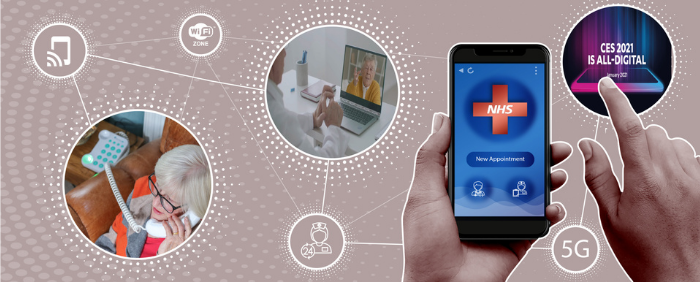Whilst many businesses have found the past year challenging, the healthcare industry has seen an increase in investment opportunities. In many cases, there have been easier and therefore more rapid routes to market than projections allowed. There are some particularly exciting areas for innovation in healthcare and last week’s CES event highlighted some that we have been working on ourselves at IEX, and our parent company, Plextek.
Using Technology to Democratise Healthcare
One good thing to come out of 2020 is progress in using tech to help democratise healthcare especially in communities that have historically had poorer access. This can be through removing geographic limitations, or other barriers to access: cost, time, or travel. Access to online or ‘at home’ diagnostic tools can enable patients to be in control of their own health, with potentially reduced costs against physical visits to professionals.
It can be hard for healthcare organisations to gain trust from demographics who have previously not used diagnostic services. Trust is essential for uptake. There needs to be a presence in communities on the ground to understand issues, providers need to put in the time and be present – there are no shortcuts.
Many people have access to a smartphone but not high-speed broadband – providing free communications could remove one of the biggest barriers as data costs / limited bandwidth can restrict what is possible.
As has been seen in research in the UK, broadband is increasingly seen as an essential service. A speaker at CES referenced that 1/3 Black Americans don’t have high-speed broadband at home (PEW Research). This shows one of the challenges of democratising anything and the uneven spread of infrastructure that we might take for granted.
The Covid pandemic has accelerated the trend that more initial healthcare evaluations will be done in the comfort of your own home in the future. Access to technology will be key to democratising this ability towards a goal of equal life span for all.
Summary of Healthcare Areas that have seen growth or investment:
- Mental health / behaviour: sometimes machines are more approachable than humans meaning contact could be made earlier before severe incidents.
- Telehealth: many people have now used it in some way and can see benefits
- Fitness / wellness: increased interest and awareness with a combination of health and lifestyle choices
- Services (rather than physical devices): these have been in development for many years, often involving real doctors, and are now taking off.
- Data aggregation: this is a somewhat interesting and potentially useful area for both individual whole body management and also to evaluate population trends. Early prevention is a key theme through the integration of AI / ownership of data / improved validity through approvals / continuous monitoring
- Applications: Specific applications such as sleep monitoring or targeting specific diseases are showing the greatest benefit at present for devices.
Get off the phone!
Most of the Home Health calls in 2020 were by telephone – not video or web conference despite the technology being quite mature. The population at greatest need is seniors who are most comfortable with the telephone – it is an ultra mature technology. Where-as video and web calls (and typically with a specialist platform) took longer for patients to get used to (and when there is only 10-15mins for a consultation you run out of time quickly!).
However, a visual aid for diagnostics could speed processes and relieve bottlenecks in our healthcare services.
In some cases, the technology is ready, but it requires the people and the processes to enable a successful rollout.

